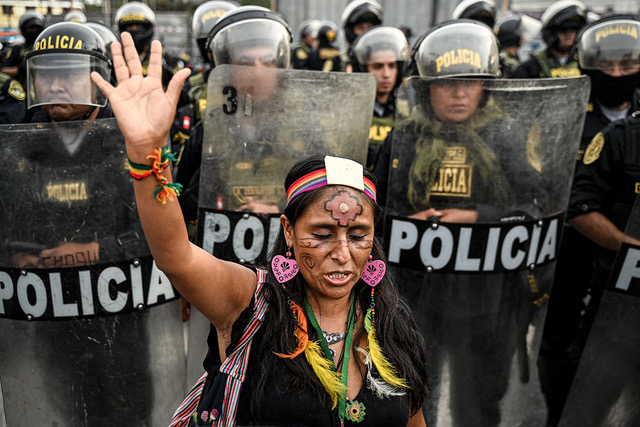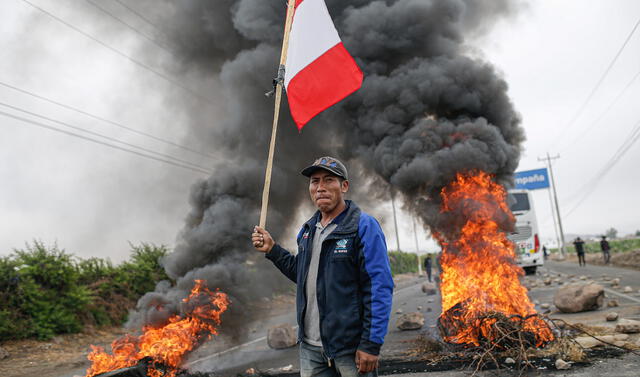Luís Hernández Navarro

The South of Peru burns. Irate over the infringement on the peoples’will and governmental repression, protesters burned banks in Yunguyo, the department of Puno. They did the same in the police headquarters of Triunfo, Arequipa. In the encampment of the Antapaccay company, in Cuzco, the population looted company property and set fire to the facilities. The blaze has also burned television stations, and politicians’ residences in other cities.
The list of documented protests is endless. The majority are peaceful, which does not prevent police violence from being directed against them. According to the Public Defender’s Office, on January 22nd, there were 78 blockades in 23 provinces. (shorturl.at/nACDR). Among other actions, there have been takeovers of airports, pickets of roads, bridges and railways; attempts to occupy the military barracks in the Llave district. According to the authorities, there have been 14 attacks against judicial headquarters, and seven fires in their buildings, as well as 34 protests against police stations, four of which became bonfires. And of course, the massive occupation of Lima.
Popular ire overflows in multiple regions. Congressmen, like the pro-Fujimori Tania Tajamarca are expelled with stones when they return to their district. But the citizen’s rage doesn’t distinguish between political parties. “Are you happy with the results, Ms. Susel? How does it feel going to sleep every day with those 52 dead?”, a woman demanded of Congresswoman Susel Paredes, an LGBT activist.
The pyres haven’t been lit by small radical groups. They are, along with the road blockades, the clashes with police, the takeover of public offices, a work of a popular uprising in process. It is a modern Fuente Ovejuna that grows beyond parties, fed by peasant patrols, popular groups that have the territory as their identity, small merchants, teachers, indigenous communities, transportation workers, unions and student groups. It is the return of the Cuatro Regiones Juntas Four Regions Together (Tawantinsuyo, in Quechua).
The heterogeneous and diverse popular movement that moves through the country like the magma of a volcano does not claim particular demands. The protagonists have set aside their specific demands. They are, from the outset, a power that is destitute of the old political regime, demanding the resignation of the de facto usurper government, of its president Dina Boluarte and of the Congress. Without formulating it in this way, it sustains a kind of “They all must go! It calls for new elections and an endorsement of a Constituent Assembly, as well as the release of Pedro Castillo. The most recent survey of the Institute of Peruvian Studies indicates that 69 percent of those consulted agree with calling for a Constituent Assembly to change the Constitution.
In a structurally racist and classist country like Peru, with the oligarchy of Lima lording it over the provinces, an enormous army of precarious workers, the systematic substitution of works and services and the endemic political persecution of social fighters, the popular revolt underway is also fed by old grievances, which today rise to the surface. Fueled by anger and social resentment, it is a movement for dignity, formulated in a political key.
The Peruvian State, wrote Héctor Béjar, one of the great ethical-political intellectual references of the nation, is a ship full of holes, sailing without a compass and without a captain. Captains are fleeting. They arrive thinking about what they are going to take with them. It is a State in a situation of disability, in which it cannot do anything, because everything has to be contracted with private companies (https://rb.gy/bzkmer). A State that is a power in copper production and yet has not been able to prevent 41 large mining contracts from being paralyzed by the resistance of the communities, nor does it have the strength to begin to renegotiate the pacts signed by Fujimori that end in 2023.
The movement has a start date (December 7), but there is no end in sight. Its permanence is surprising, in spite of the savage repression by the de facto civilian-military government, which has declared the suspension of constitutional guarantees and assassinated more than 60 people; its advance in waves; its wisdom in retreating during the Christmas holidays and reemerging with more vigor and convening capacity at the end of the holidays; its power to organize a new March of the Four of Their Own, similar to the one that in 2000 marked the beginning of the end of Fujimori’s dictatorship, while it controls the south of the country; the solidarity networks that feed, host, supply water, transport, heal and protect it.

With its own particularities, the Peruvian uprising against the dictatorship adds to the cycle of popular mobilizations from below that have shaken Ecuador, Chile, Colombia and Bolivia in recent years. As these South American experiences show, their outcome is uncertain. History does not advance in a straight line.
Big transnational mining capital demands stability and guarantees for its investments and will use all its resources and influence to maintain them. Although the decision to repress popular insubordination has broad consensus in the Peruvian right wing, the usurper government of Boluarte is not viable in the medium term. Notwithstanding the magnitude of the violence against the insurgents can drown in blood and fire, in the short term, there is this destituent push of Peru from below. The Peruvian people have become the subject of their own destiny. All solidarity to their heroic struggle!
*Luis Hernández Navarro draws upon Giorgio Agamben’s concept of “destituent power” or “ungovernability” to describe the strength of popular uprising in Peru. “Destituent power outlines a force that, in its very constitution, deactivates the governmental machine.” – Critical Theory
This article was published in Spanish in La Jornada on January 24th, 2023. https://www.jornada.com.mx/2023/01/24/opinion/010a2pol
English interpretation by Chiapas Support Committee Oakland and re-posted by Schools for Chiapas.
